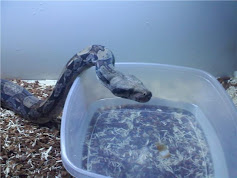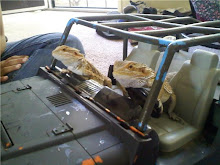
The African fat tailed gecko (Hemitheconyx Caudicinctus) originates in West Africa, and has steadily been making its mark in the pet trade as a reptile enthusiast favorite. They have not yet achieved the notoriety or popularity of the leopard gecko, but they are gaining ground! These little guys reach an average length of 8-10 inches, and can keep you company for 15 years.
These easy to keep reptiles make pet care simple as they require little space and maintenance. The African fat tailed gecko species as a whole has acclimated well to being kept in captivity and are generally very friendly and docile; however, wild caught specimens do make it into the pet shops from time to time and are not happy about it! They will be more than happy to let you know by nipping your fingers...
Always make sure and ask if the lizard you are interested in is captive bred! A captive bred African fat tail gecko tends to be better behaved, and has less of a chance to be harboring parasites. :)
Housing
If you have limited space, a 10 gallon tank will work great. It does not have to have a sliding mesh top, but I would recommend it. African fat tailed geckos don't have climbing pads on their feet, so the purpose isn't to keep them in. It is to keep your curious cat from discovering a tasty snack!
A 20 gallon tank is ideal, and you can safely keep two in this size enclosure. Avoid keep more than one male to a cage because they will fight and hurt, or worse, kill each other. Females will generally get along quite well. Pet shops usually sell females, but make sure you ask so you know what you are getting.
There are four main components for effective housing of the african fat tailed gecko.
•Two hiding spots
•Shallow water dish
•A suitible substrate (newspaper is great)
•Under the tank heating pad
Place two hiding spots at opposite ends of the enclosure. Place the heating pad under one side of the tank, and the water dish on the other. We supply the hiding spots to provide a sense of security. A stressed out, vulnerable feeling reptile won't be healthy for long.
Reptiles need a heating source to help them thermoregulate, so that is where the under the tank heater comes in (also known as a heating pad). The end of the tank we place this under is referred to the warm end of the enclosure. It makes it difficult for them to digest their meals and function properly if they don't have the ability to indirectly control their temperature.
The substrate is very important. Avoid using anything sandy, dusty, or strong in smell. It can cause respiratory distress and make your fat tailed gecko sick. Substrate that is too small in size (sand or tiny wood chips) can be accidently ingested.
This is called impaction, and can kill your pet! I wouldn't even use the reptile sand products that claim to prevent impaction. It has been proven that even these are not fully digestible.
The best substrate in my opinion is newspaper. Sure, it looks terrible, and I'm aware that geckos can't read, but it is really convienient.
If you want to make your enclosure look a little more natural, then you might be interested in picking up some aspen shavings. Every pet store that is worth visiting has some for sale.
After the tank is set up, it is just a matter of picking up poop every couple days, and doing a deep cleaning every few months. One part bleach and 25+ parts water is very effective.
Heating, Lighting, and Humidity
Temperatures ranging from 80-85 degrees fahrenheit in the day, and 75-80 degrees during the night are ideal. Generally speaking, room temperature supplemented with an under the tank heating pad covering 1/3rd of the enclosure will do just fine.
The african fat tailed gecko does not require any special lighting or ultra violet lights. They are more active during the evening and night time hours, so they do not rely on direct heat from the sun. A UV light couldn't hurt, but there is little evidence to support it will.
You may be persuaded to buy a heat rock instead of a heating pad, but I would urge you to resist the temptation. Hot rocks have the tenancy to get too hot in some areas. The concentration of heat can be enough to kill or badly injure a gecko.
Proper humidity can be maintained very easily by misting the enclosure with a water bottle once daily. This should be enough to help them shed, but if you are having shedding problems there is something else you can do as well. You may want to create a humidity hide box by packing a hiding place with moss, and misting it daily. You can make the humidity hide out of an empty tupperware container if you so choose!
Feeding
You can safely feed a variety of insects including but not limited to crickets, meal worms, and wax worms. Crickets, although not having great nutritional value, can provide a source of exercise for your gecko. To make them a little more suitable for consumption, gut load them for 24 hours by offering the crickets some form of cricket feed.
Remember, you are what you eat and The african fat tailed gecko is no exception! You want to make sure your reptile is eating healthy food items. Gut loading them helps make the meal that much more fulfilling.
Offer baby fat tailed geckos food twice daily, juveniles food daily, and adults food every other day.You will want to dust food items with a suitable vitamin supplement once a week in addition to gut loading.
Always feed food that is smaller than your gecko's head as a general gecko pet care guideline, and remove any uneaten insects within twenty minutes. Crickets can be especially irritating and stressful for a lizard to deal with crawling all over them. If the cricket is hungry enough, it may try to nibble on your gecko!
Boa.jpg)



No comments:
Post a Comment